

68 Best Chemistry Experiments: Learn About Chemical Reactions
Whether you’re a student eager to explore the wonders of chemical reactions or a teacher seeking to inspire and engage your students, we’ve compiled a curated list of the top 68 chemistry experiments so you can learn about chemical reactions.
While the theories and laws governing chemistry can sometimes feel abstract, experiments bridge the gap between these concepts and their tangible manifestations. These experiments provide hands-on experiences illuminating the intricacies of chemical reactions, molecular structures, and elemental properties.
1. Covalent Bonds

By engaging in activities that demonstrate the formation and properties of covalent bonds, students can grasp the significance of these bonds in holding atoms together and shaping the world around us.
Learn more: Covalent Bonds
2. Sulfuric Acid and Sugar Demonstration
Through this experiment, students can develop a deeper understanding of chemical properties, appreciate the power of chemical reactions, and ignite their passion for scientific exploration.
3. Make Hot Ice at Home
Making hot ice at home is a fascinating chemistry experiment that allows students to witness the captivating transformation of a liquid into a solid with a surprising twist.
4. Make a Bouncing Polymer Ball

This hands-on activity not only allows students to explore the fascinating properties of polymers but also encourages experimentation and creativity.
Learn more: Thought Co
5. Diffusion Watercolor Art

This experiment offers a wonderful opportunity for students to explore the properties of pigments, observe how they interact with water, and discover the mesmerizing patterns and textures that emerge.
Learn more: Diffusion Watercolor Art
6. Exploding Baggie

The exploding baggie experiment is a captivating and dynamic demonstration that students should engage in with caution and under the supervision of a qualified instructor.
Learn more: Exploding Baggie
7. Color Changing Chemistry Clock

This experiment not only engages students in the world of chemical kinetics but also introduces them to the concept of a chemical clock, where the color change acts as a timekeeping mechanism.
Learn more: Color Changing Chemistry Clock
8. Pipe Cleaner Crystal Trees

By adjusting the concentration of the Borax solution or experimenting with different pipe cleaner arrangements, students can customize their crystal trees and observe how it affects the growth patterns.
Learn more: Pipe Cleaner Crystal Trees
9. How To Make Ice Sculptures

Through this experiment, students gain a deeper understanding of the physical and chemical changes that occur when water freezes and melts.
Learn more: Ice Sculpture
10. How to Make Paper

Through this hands-on activity, students gain a deeper understanding of the properties of cellulose fibers and the transformative power of chemical reactions.
Learn more: How to Make Paper
11. Color Changing Chemistry
Color changing chemistry is an enchanting experiment that offers a captivating blend of science and art. Students should embark on this colorful journey to witness the mesmerizing transformations of chemicals and explore the principles of chemical reactions.
12. Gassy Banana
The gassy banana experiment is a fun and interactive way for students to explore the principles of chemical reactions and gas production.
Learn more: Gassy Banana
13. Gingerbread Man Chemistry Experiment

This hands-on activity not only introduces students to the concepts of chemical leavening and heat-induced reactions but also allows for creativity in decorating and personalizing their gingerbread creations.
Learn more: Gingerbread Man Chemistry Experiment
14. Make Amortentia Potion

While the love potion is fictional, this activity offers a chance to explore the art of potion-making and the chemistry behind it.
Learn more: How to Make Amortentia Potion
15. Strawberry DNA Extraction
This hands-on experiment offers a unique opportunity to observe DNA, the building blocks of life, up close and learn about its structure and properties.
16. Melting Snowman

The melting snowman experiment is a fun and whimsical activity that allows students to explore the principles of heat transfer and phase changes.
Learn more: Melting Snowman
17. Acid Base Cabbage Juice

The acid-base cabbage juice experiment is an engaging and colorful activity that allows students to explore the pH scale and the properties of acids and bases.
By extracting the purple pigment from red cabbage leaves and creating cabbage juice, students can use this natural indicator to identify and differentiate between acidic and basic substances.
Learn more: Acid Base Cabbage Juice
18. Magic Milk
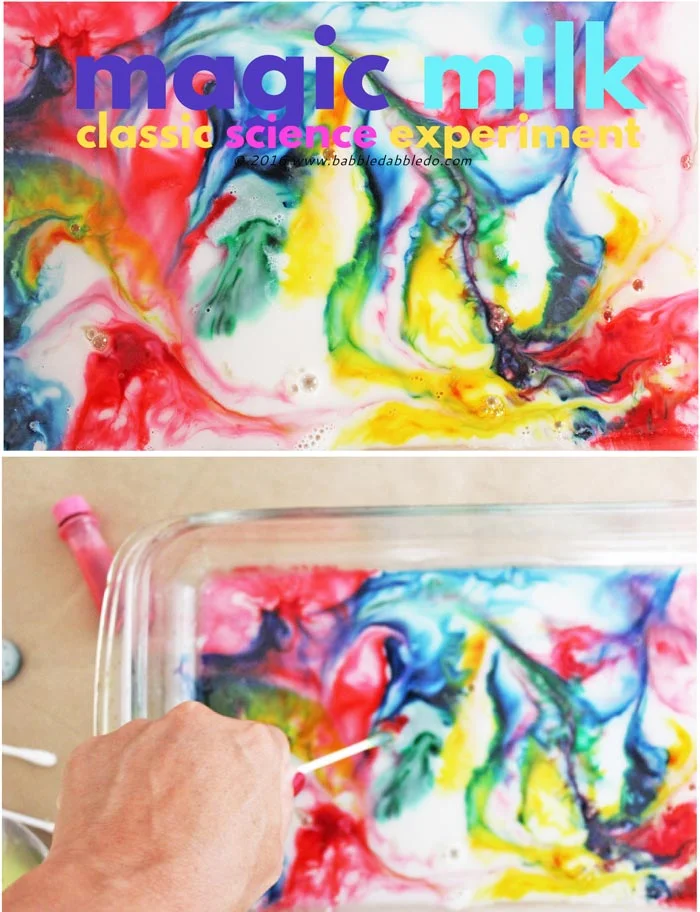
The magic milk experiment is a mesmerizing and educational activity that allows students to explore the concepts of surface tension and chemical reactions.
By adding drops of different food colors to a dish of milk and then introducing a small amount of dish soap, students can witness a captivating display of swirling colors and patterns.
Learn more: Magic Milk
19. Melting Ice with Salt and Water

Through this hands-on activity, students can gain a deeper understanding of the science behind de-icing and how different substances can influence the physical properties of water.
Learn more: Melting Ice with Salt and Water
20. Barking Dog Chemistry Demonstration

The barking dog chemistry demonstration is an exciting and visually captivating experiment that showcases the principles of combustion and gas production.
21. How to Make Egg Geodes

Making egg geodes is a fascinating and creative chemistry experiment that students should try. By using common materials like eggshells, salt, and food coloring, students can create their own beautiful geode-like crystals.
Learn more: How to Make Egg Geodes
22. Make Sherbet

This experiment not only engages the taste buds but also introduces concepts of acidity, solubility, and the chemical reactions that occur when the sherbet comes into contact with moisture.
Learn more: Make Sherbet
23. Hatch a Baking Soda Dinosaur Egg

As the baking soda dries and hardens around the toy, it forms a “shell” resembling a dinosaur egg. To hatch the egg, students can pour vinegar onto the shell, causing a chemical reaction that produces carbon dioxide gas.
Learn more: Steam Powered Family
24. Chromatography Flowers

By analyzing the resulting patterns, students can gain insights into the different pigments present in flowers and the science behind their colors.
Learn more: Chromatography Flowers
25. Turn Juice Into Solid

Turning juice into a solid through gelification is an engaging and educational chemistry experiment that students should try. By exploring the transformation of a liquid into a solid, students can gain insights of chemical reactions and molecular interactions.
Learn more: Turn Juice into Solid
26. Bouncy Balls
Making bouncy balls allows students to explore the fascinating properties of polymers, such as their ability to stretch and rebound.
27. Make a Lemon Battery
Creating a lemon battery is a captivating and hands-on experiment that allows students to explore the fundamentals of electricity and chemical reactions.
28. Mentos and Soda Project
The Mentos and soda project is a thrilling and explosive experiment that students should try. By dropping Mentos candies into a bottle of carbonated soda, an exciting eruption occurs.
29. Alkali Metal in Water
The reaction of alkali metals with water is a fascinating and visually captivating chemistry demonstration.
30. Rainbow Flame
The rainbow flame experiment is a captivating and visually stunning chemistry demonstration that students should explore.
31. Sugar Yeast Experiment
This experiment not only introduces students to the concept of fermentation but also allows them to witness the effects of a living organism, yeast, on the sugar substrate.
32. The Thermite Reaction
The thermite reaction is a highly energetic and visually striking chemical reaction that students can explore with caution and under proper supervision.
This experiment showcases the principles of exothermic reactions, oxidation-reduction, and the high temperatures that can be achieved through chemical reactions.
33. Polishing Pennies
Polishing pennies is a simple and enjoyable chemistry experiment that allows students to explore the concepts of oxidation and cleaning methods.
34. Elephant Toothpaste
The elephant toothpaste experiment is a thrilling and visually captivating chemistry demonstration that students should try with caution and under the guidance of a knowledgeable instructor.
35. Magic Potion
Creating a magic potion is an exciting and imaginative activity that allows students to explore their creativity while learning about the principles of chemistry.
36. Color Changing Acid-Base Experiment

Through the color changing acid-base experiment, students can gain a deeper understanding of chemical reactions and the role of pH in our daily lives.
Learn more: Color Changing Acid-Base Experiment
37. Fill up a Balloon
Filling up a balloon is a simple and enjoyable physics experiment that demonstrates the properties of air pressure. By blowing air into a balloon, you can observe how the balloon expands and becomes inflated.
38. Jello and Vinegar

The combination of Jello and vinegar is a fascinating and tasty chemistry experiment that demonstrates the effects of acid on a gelatin-based substance.
Learn more: Jello and Vinegar
39. Vinegar and Steel Wool Reaction

This experiment not only provides a visual demonstration of the oxidation process but also introduces students to the concept of corrosion and the role of acids in accelerating the process.
Learn more: Vinegar and Steel Wool Reaction
40. Dancing Rice

The dancing rice experiment is a captivating and educational demonstration that showcases the principles of density and buoyancy.
By pouring a small amount of uncooked rice into a clear container filled with water, students can witness the rice grains moving and “dancing” in the water.
Learn more: Dancing Rice
41. Soil Testing Garden Science

Soil testing is a valuable and informative experiment that allows students to assess the composition and properties of soil.
By collecting soil samples from different locations and analyzing them, students can gain insights into the nutrient content, pH level, and texture of the soil.
Learn more: Soil Testing Garden Science
42. Heat Sensitive Color Changing Slime

Creating heat-sensitive color-changing slime is a captivating and playful chemistry experiment that students should try.
Learn more: Left Brain Craft Brain
43. Experimenting with Viscosity

Experimenting with viscosity is an engaging and hands-on activity that allows students to explore the flow properties of liquids.
Viscosity refers to a liquid’s resistance to flow, and this experiment enables students to investigate how different factors affect viscosity.
Learn more: Experimenting with Viscosity
44. Rock Candy Science

Rock candy science is a delightful and educational chemistry experiment that students should try. By growing their own rock candy crystals, students can learn about crystal formation and explore the principles of solubility and saturation.
Learn more: Rock Candy Science
45. Baking Soda vs Baking Powder

Baking soda and baking powder have distinct properties that influence the leavening process in different ways.
This hands-on experiment provides a practical understanding of how these ingredients interact with acids and moisture to create carbon dioxide gas.
46. Endothermic and Exothermic Reactions Experiment

The endothermic and exothermic reactions experiment is an exciting and informative chemistry exploration that students should try.
By observing and comparing the heat changes in different reactions, students can gain a deeper understanding of energy transfer and the concepts of endothermic and exothermic processes.
Learn more: Education.com
47. Diaper Chemistry

By dissecting a diaper and examining its components, students can uncover the chemical processes that make diapers so effective at absorbing and retaining liquids.
Learn more: Diaper Chemistry
48. Candle Chemical Reaction
The “Flame out” experiment is an intriguing and educational chemistry demonstration that students should try. By exploring the effects of a chemical reaction on a burning candle, students can witness the captivating moment when the flame is extinguished.
49. Make Curds and Whey

This experiment not only introduces students to the concept of acid-base reactions but also offers an opportunity to explore the science behind cheese-making.
Learn more: Tinkerlab
50. Grow Crystals Overnight

By creating a supersaturated solution using substances like epsom salt, sugar, or borax, students can observe the fascinating process of crystal growth. This experiment allows students to explore the principles of solubility, saturation, and nucleation.
Learn more: Grow Crystals Overnight
51. Measure Electrolytes in Sports Drinks
The “Measure Electrolytes in Sports Drinks” experiment is an informative and practical chemistry activity that students should try.
By using simple tools like a multimeter or conductivity probe, students can measure the electrical conductivity of different sports drinks to determine their electrolyte content.
52. Oxygen and Fire Experiment
The oxygen and fire experiment is a captivating and educational chemistry demonstration that students should try. By observing the effects of oxygen on a controlled fire, students can witness the essential role of oxygen in supporting combustion.
53. Electrolysis Of Water

The electrolysis of water experiment is a captivating and educational chemistry demonstration that students should try.
Learn more: Electrolysis Of Water
54. Expanding Ivory Soap

The expanding Ivory Soap experiment is a fun and interactive chemistry activity that students should try. By placing a bar of Ivory soap in a microwave, students can witness the remarkable expansion of the soap as it heats up.
Learn more: Little Bins Little Hands
55. Glowing Fireworks

This experiment not only introduces students to the principles of pyrotechnics and combustion but also encourages observation, critical thinking, and an appreciation for the physics and chemistry behind.
Learn more: Glowing Fireworks
56. Colorful Polymer Chemistry

Colorful polymer chemistry is an exciting and vibrant experiment that students should try to explore polymers and colorants.
By combining different types of polymers with various colorants, such as food coloring or pigments, students can create a kaleidoscope of colors in their polymer creations.
Learn more: Colorful Polymer Chemistry
57. Sulfur Hexafluoride- Deep Voice Gas
This experiment provides a firsthand experience of how the density and composition of gases can influence sound transmission.
It encourages scientific curiosity, observation, and a sense of wonder as students witness the surprising transformation of their voices.
58. Liquid Nitrogen Ice Cream
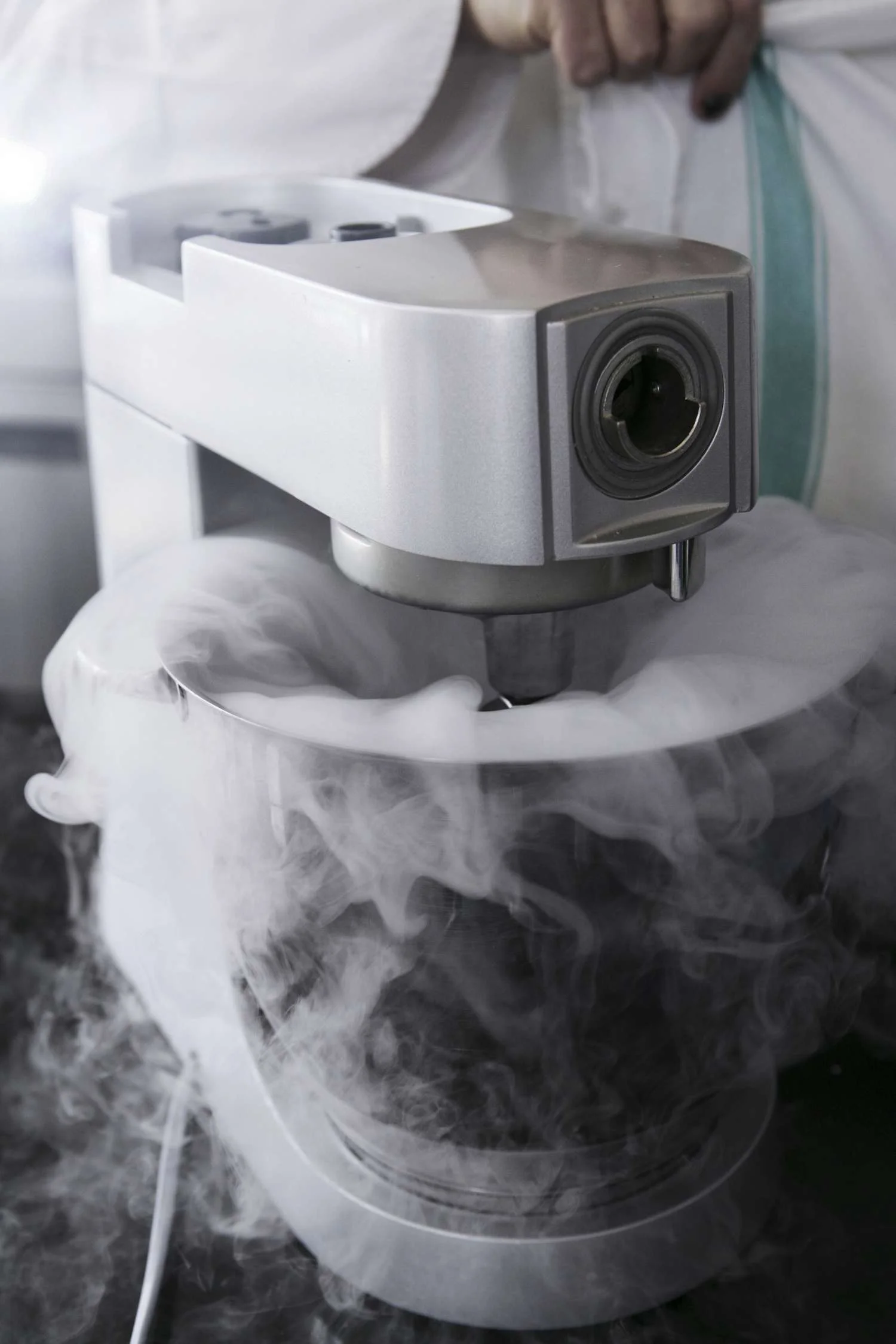
Liquid nitrogen ice cream is a thrilling and delicious chemistry experiment that students should try. By combining cream, sugar, and flavorings with liquid nitrogen, students can create ice cream with a unique and creamy texture.
59. White Smoke Chemistry Demonstration

The White Smoke Chemistry Demonstration provides an engaging and visually captivating experience for students to explore chemical reactions and gases. By combining hydrochloric acid and ammonia solutions, students can witness the mesmerizing formation of white smoke.
60. Nitrogen Triiodide Chemistry Demonstration

The nitrogen triiodide chemistry demonstration is a remarkable and attention-grabbing experiment that students should try under the guidance of a knowledgeable instructor.
By reacting iodine crystals with concentrated ammonia, students can precipitate nitrogen triiodide (NI3), a highly sensitive compound.
61. Make a Plastic- Milk And Vinegar Reaction Experiment

Through the “Make a Plastic – Milk and Vinegar Reaction” experiment, students can gain a deeper understanding of the chemistry behind plastics, environmental sustainability, and the potential of biodegradable materials.
Learn more: Rookie Parenting
62. Eno and Water Experiment
This experiment not only introduces students to acid-base reactions but also engages their senses as they witness the visible and audible effects of the reaction.
63. The Eternal Kettle Experiment
By filling a kettle with alcohol and igniting it, students can investigate the behavior of the alcohol flame and its sustainability.
64. Coke and Chlorine Bombs
Engaging in this experiment allows students to experience the wonders of chemistry firsthand, making it an ideal choice to ignite their curiosity and passion for scientific exploration.
65. Set your Hand on Fire
This experiment showcases the fascinating nature of combustion and the science behind fire.
By carefully following proper procedures and safety guidelines, students can witness firsthand how the sanitizer’s high alcohol content interacts with an open flame, resulting in a brief but captivating display of controlled combustion.
66. Instant Ice Experiments
The Instant Ice Experiment offers an engaging and captivating opportunity for students to explore the wonders of chemistry and phase changes.
By using simple household ingredients, students can witness the fascinating phenomenon of rapid ice formation in just a matter of seconds.
67. Coke Cans in Acid and Base
Engaging in this experiment allows students to gain a deeper understanding of the chemical properties of substances and the importance of safety protocols in scientific investigations.

68. Color Changing Invisible Ink

The Color Changing Invisible Ink experiment offers an intriguing and fun opportunity for students to explore chemistry and learn about the concept of chemical reactions.
Learn more: Research Parent
Similar Posts:
- Top 100 Fine Motor Skills Activities for Toddlers and Preschoolers
- 37 Water Science Experiments: Fun & Easy
- Top 58 Creative Art Activities for Kids and Preschoolers
Leave a Comment Cancel reply
Save my name and email in this browser for the next time I comment.
- Science, Tech, Math ›
- Chemistry ›
- Projects & Experiments ›
10 Cool Chemistry Experiments
ThoughtCo / Hilary Allison
- Projects & Experiments
- Chemical Laws
- Periodic Table
- Scientific Method
- Biochemistry
- Physical Chemistry
- Medical Chemistry
- Chemistry In Everyday Life
- Famous Chemists
- Activities for Kids
- Abbreviations & Acronyms
- Weather & Climate
- Ph.D., Biomedical Sciences, University of Tennessee at Knoxville
- B.A., Physics and Mathematics, Hastings College
Chemistry is king when it comes to making science cool. There are many interesting and fun projects to try, but these 10 chemistry experiments might be the coolest.
Whether you want to witness color transformations with copper and nitric acid or create a foam spectacle with hydrogen peroxide and potassium iodide, there's something here to spark curiosity in everyone. There's even a famous chemical reaction that will emit blue light and a characteristic barking or woofing sound.
Copper and Nitric Acid
When you place a piece of copper in nitric acid , the Cu 2+ ions and nitrate ions coordinate to color the solution green and then brownish-green. If you dilute the solution, water displaces nitrate ions around the copper, and the solution changes to blue.
Hydrogen Peroxide with Potassium Iodide
Affectionately known as elephant toothpaste , the chemical reaction between peroxide and potassium iodide shoots out a column of foam. If you add food coloring, you can customize the "toothpaste" for holiday-colored themes.
Any Alkali Metal in Water
Any of the alkali metals will react vigorously in water . How vigorously? Sodium burns bright yellow. Potassium burns violet. Lithium burns red. Cesium explodes. Experiment by moving down the alkali metals group of the periodic table.
Thermite Reaction
The thermite reaction essentially shows what would happen if iron rusted instantly, rather than over time. In other words, it's making metal burn. If the conditions are right, just about any metal will burn. However, the reaction usually is performed by reacting iron oxide with aluminum:
Fe 2 O 3 + 2Al → 2Fe + Al 2 O 3 + heat and light
If you want a truly stunning display, try placing the mixture inside a block of dry ice and then lighting the mixture.
Coloring Fire
SEAN GLADWELL / Getty Images
When ions are heated in a flame, electrons become excited and then drop to a lower energy state, emitting photons. The energy of the photons is characteristic of the chemical and corresponds to specific flame colors . It's the basis for the flame test in analytical chemistry , plus it's fun to experiment with different chemicals to see what colors they produce in a fire.
Make Polymer Bouncy Balls
Who doesn't enjoy playing with bouncy balls ? The chemical reaction used to make the balls makes a terrific experiment because you can alter the properties of the balls by changing the ratio of the ingredients.
Make a Lichtenberg Figure
A Lichtenberg figure or "electrical tree" is a record of the path taken by electrons during an electrostatic discharge. It's basically frozen lightning. There are several ways you can make an electrical tree.
Experiment with 'Hot Ice'
Hot ice is a name given to sodium acetate, a chemical you can make by reacting vinegar and baking soda. A solution of sodium acetate can be supercooled so that it will crystallize on command. Heat is evolved when the crystals form, so although it resembles water ice, it's hot.
Barking Dog Experiment
The Barking Dog is the name given to a chemiluminescent reaction involving the exothermic combination of either nitrous oxide or nitrogen monoxide with carbon disulfide. The reaction proceeds down a tube, emitting blue light and a characteristic "woof" sound.
Another version of the demonstration involves coating the inside of a clear jug with alcohol and igniting the vapor. The flame front proceeds down the bottle , which also barks.
Dehydration of Sugar
When you react sugar with sulfuric acid , the sugar is violently dehydrated. The result is a growing column of carbon black, heat, and the overwhelming odor of burnt caramel.
Easy Science Experiments
Want something less extravagant but still fun? These easy science experiments are doable with items you likely already have at home—from creating invisible ink with baking soda to making homemade ice cream in a plastic bag.
- Where to Buy Saltpeter or Potassium Nitrate
- Vitamin C Determination by Iodine Titration
- Cool Dry Ice Experiments
- How to Make Bubbles That Don't Pop
- Equation for the Reaction Between Baking Soda and Vinegar
- 5 Ways to Make Glue
- How to Grow Table Salt or Sodium Chloride Crystals
- Color Change Chemistry Experiments
- How to Melt Aluminum Cans at Home
- 10 Cool Chemistry Demonstrations for Educators
- Science Projects for Every Subject
- 10 Fun Chemistry Demonstrations and Experiments
- Valentine's Day Chemistry
- Thames & Kosmos Chem 3000 Chemistry Kit Review
- Halloween Reaction or Old Nassau Reaction
- How to Do the Color Change Chameleon Chemistry Demonstration
- Grades 6-12
- School Leaders
FREE Thanksgiving Worksheet Bundle for Last-Minute Activities 🦃
Every product is independently selected by our team of teacher-reviewers and editors. Things you buy through our links may earn us a commission.
45 Cool Chemistry Experiments, Demos, and Science Fair Projects
Don’t forget your safety equipment!
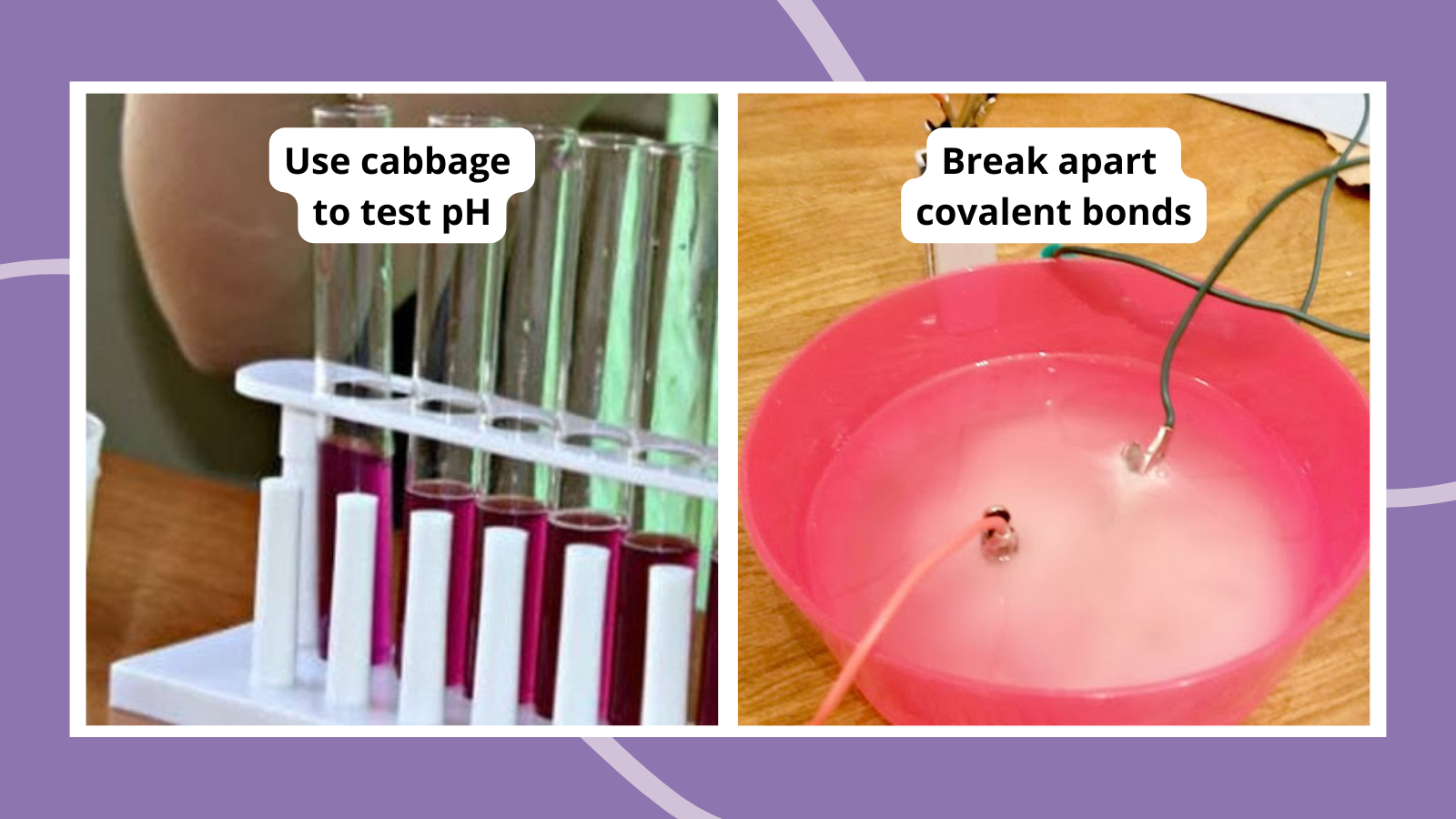
Bunsen burners, colorful chemicals, and the possibility of a (controlled) explosion or two? Everybody loves chemistry experiments! We’ve rounded up the best activities, demos, and chemistry science fair projects for kids and teens. Try them in the classroom or at home.
Easy Chemistry Experiments and Activities for All Ages
Chemistry science fair projects.
These chemistry experiments and activities are all easy to do using simple supplies you probably already have. Families can try them at home, or teachers and students can do them together in the classroom.
Mix up some magic milk
Kids love this colorful experiment, which explores the concept of surface tension. This is one of our favorite chemistry experiments to try at home, since the supplies are so basic and the results are so cool!
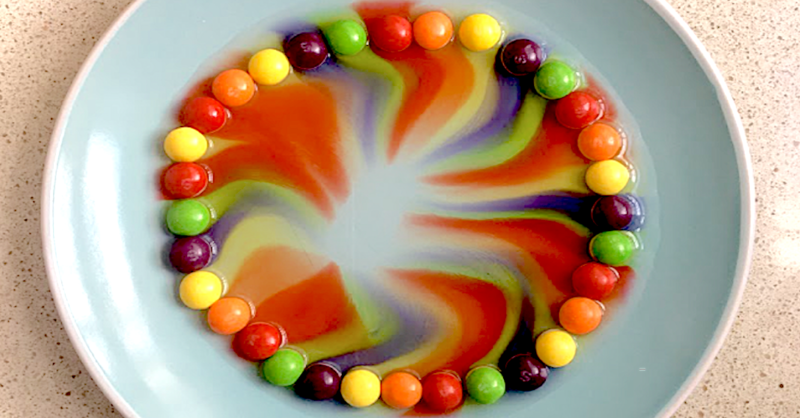
Taste the Rainbow
Teach your students about diffusion while creating a beautiful and tasty rainbow. You’ll definitely want to have extra Skittles on hand so your class can enjoy a few as well!
Learn more: Skittles Diffusion
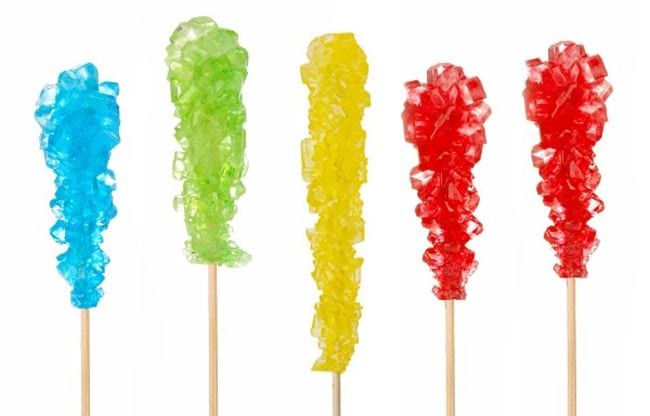
Crystallize sweet treats
Crystal science experiments teach kids about supersaturated solutions. This one is easy to do at home, and the results are absolutely delicious!
Learn more: Candy Crystals
Make elephant-sized toothpaste
This fun project uses yeast and a hydrogen peroxide solution to create overflowing “elephant toothpaste.” You can also add an extra fun layer by having kids create toothpaste wrappers for their plastic bottles.
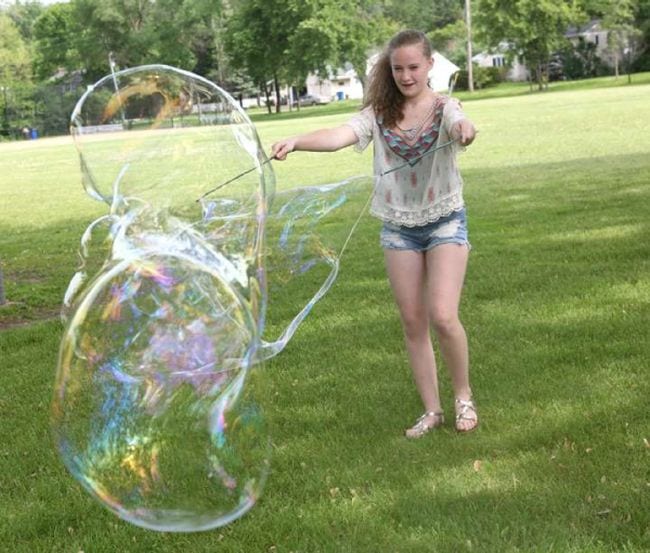
Blow the biggest bubbles you can
Add a few simple ingredients to dish soap solution to create the largest bubbles you’ve ever seen! Kids learn about surface tension as they engineer these bubble-blowing wands.
Learn more: Giant Soap Bubbles
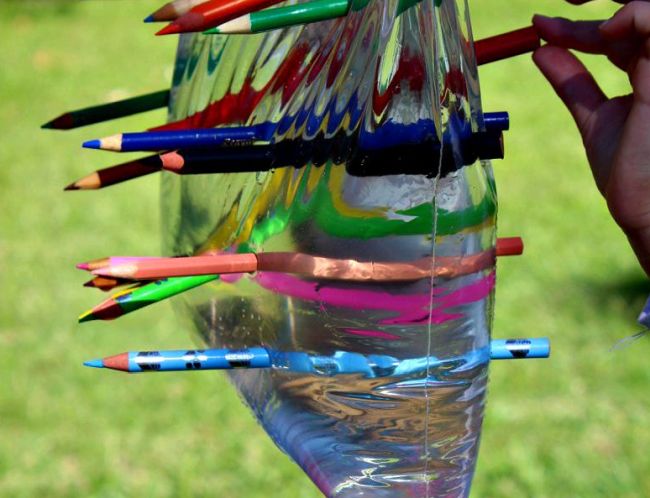
Demonstrate the “magic” leakproof bag
So simple and so amazing! All you need is a zip-top plastic bag, sharp pencils, and some water to blow your kids’ minds. Once they’re suitably impressed, teach them how the “trick” works by explaining the chemistry of polymers.
Learn more: Leakproof Bag
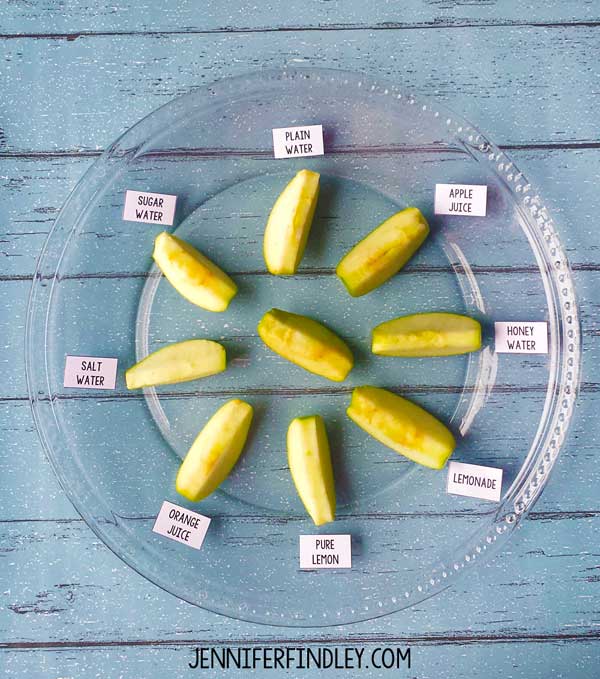
Use apple slices to learn about oxidation
Have students make predictions about what will happen to apple slices when immersed in different liquids, then put those predictions to the test! Finally, have them record their observations.
Learn more: Apple Oxidation
Float a marker man
Their eyes will pop out of their heads when you “levitate” a stick figure right off the table. This experiment works due to the insolubility of dry-erase marker ink in water, combined with the lighter density of the ink.
Learn more: Floating Marker Man

Discover density with hot and cold water
There are a lot of easy science experiments you can do with density. This one is extremely simple, involving only hot and cold water and food coloring, but the visuals make it appealing and fun.
Learn more: Layered Water

Layer more liquids
This density demo is a little more complicated, but the effects are spectacular. Slowly layer liquids like honey, dish soap, water, and rubbing alcohol in a glass. Kids will be amazed when the liquids float one on top of the other like magic (except it is really science).
Learn more: Layered Liquids

Grow a carbon sugar snake
Easy science experiments can still have impressive results. This eye-popping chemical reaction demonstration only requires simple supplies like sugar, baking soda, and sand.
Learn more: Carbon Sugar Snake

Make homemade bouncy balls
These homemade bouncy balls are easy to make since all you need is glue, food coloring, borax powder, cornstarch, and warm water. You’ll want to store them inside a container like a plastic egg because they will flatten out over time.
Learn more: Make Your Own Bouncy Balls

Create eggshell chalk
Eggshells contain calcium, the same material that makes chalk. Grind them up and mix them with flour, water, and food coloring to make your very own sidewalk chalk.
Learn more: Eggshell Chalk
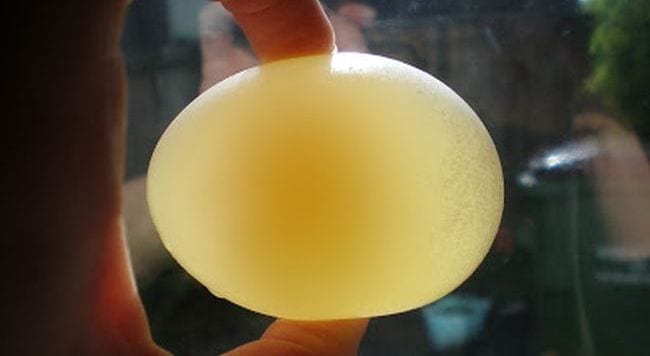
Make naked eggs
This is so cool! Use vinegar to dissolve the calcium carbonate in an eggshell to discover the membrane underneath that holds the egg together. Then, use the “naked” egg for another easy science experiment that demonstrates osmosis .
Learn more: Naked Egg Experiment
Turn milk into plastic
This sounds a lot more complicated than it is, but don’t be afraid to give it a try. Use simple kitchen supplies to create plastic polymers from plain old milk. Sculpt them into cool shapes when you’re done.

Test pH using cabbage
Teach kids about acids and bases without needing pH test strips. Simply boil some red cabbage and use the resulting water to test various substances—acids turn red and bases turn green.
Learn more: Cabbage pH

Clean some old coins
Use common household items to make old oxidized coins clean and shiny again in this simple chemistry experiment. Ask kids to predict (hypothesize) which will work best, then expand the learning by doing some research to explain the results.
Learn more: Cleaning Coins
Blow up a balloon (without blowing)
Chances are good you probably did easy science experiments like this when you were in school yourself. This well-known activity demonstrates the reactions between acids and bases. Fill a bottle with vinegar and a balloon with baking soda. Fit the balloon over the top, shake the baking soda down into the vinegar, and watch the balloon inflate.
Learn more: Balloon Experiments
Assemble a DIY lava lamp
This 1970s trend is back—as an easy science experiment! This activity combines acid/base reactions with density for a totally groovy result.
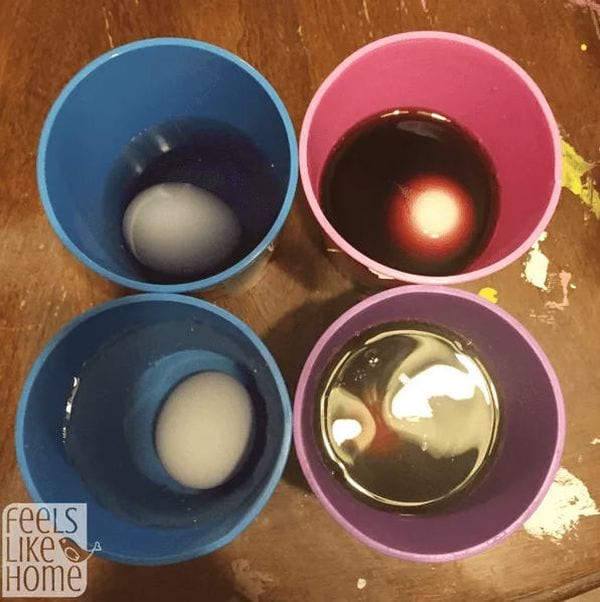
Explore how sugary drinks affect teeth
The calcium content of eggshells makes them a great stand-in for teeth. Use eggs to explore how soda and juice can stain teeth and wear down the enamel. Expand your learning by trying different toothpaste and toothbrush combinations to see how effective they are.
Learn more: Sugar and Teeth Experiment
Mummify a hot dog
If your kids are fascinated by the Egyptians, they’ll love learning to mummify a hot dog. No need for canopic jars ; just grab some baking soda and get started.
Extinguish flames with carbon dioxide
This is a fiery twist on acid-base experiments. Light a candle and talk about what fire needs in order to survive. Then, create an acid-base reaction and “pour” the carbon dioxide to extinguish the flame. The CO2 gas acts like a liquid, suffocating the fire.
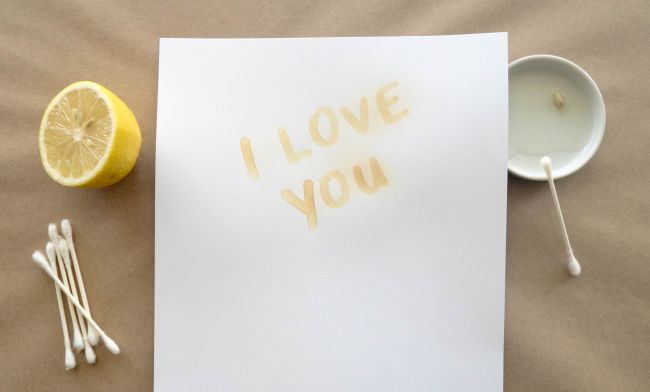
Send secret messages with invisible ink
Turn your kids into secret agents! Write messages with a paintbrush dipped in lemon juice, then hold the paper over a heat source and watch the invisible become visible as oxidation goes to work.
Learn more: Invisible Ink
Set popcorn dancing
This is a fun version of the classic baking soda and vinegar experiment, perfect for the younger crowd. The bubbly mixture causes popcorn to dance around in the water.
Learn more: Dancing Popcorn Experiment
Shoot a soda geyser sky-high
You’ve always wondered if this really works, so it’s time to find out for yourself! Kids will marvel at the chemical reaction that sends diet soda shooting high in the air when Mentos are added.
Learn more: Mentos and Coke Experiment
All of these chemistry experiments are perfect for using the scientific method. Form a hypothesis, alter the variables, and then observe the results! You can simplify these projects for younger kids, or add more complexity for older students.
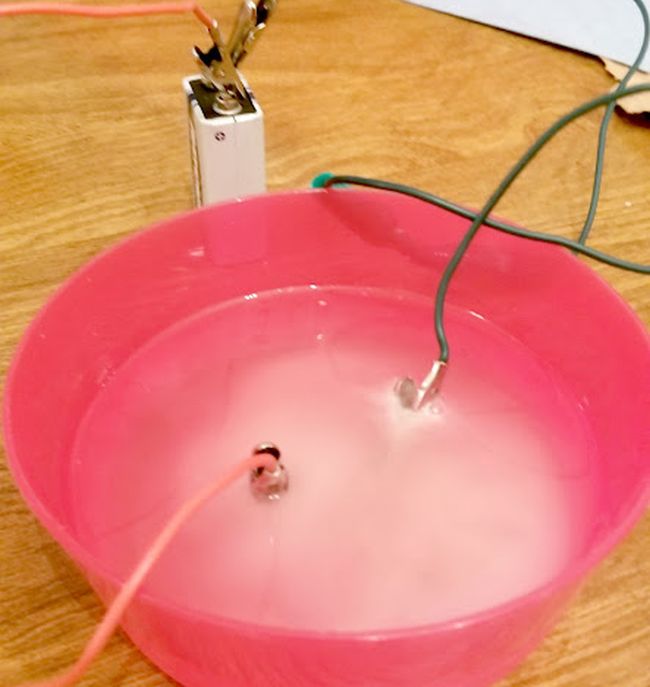
Break apart covalent bonds
Difficulty: Medium / Materials: Medium
Break the covalent bond of H 2 O into H and O with this simple experiment. You only need simple supplies for this one. Turn it into a science fair project by changing up the variables—does the temperature of the water matter? What happens if you try this with other liquids?
Learn more: Breaking Covalent Bonds
Measure the calories in various foods
Are the calorie counts on your favorite snacks accurate? Build your own calorimeter and find out! This kit from Home Science Tools has all the supplies you’ll need.

Detect latent fingerprints
Forensic science is engrossing and can lead to important career opportunities too. Explore the chemistry needed to detect latent (invisible) fingerprints, just like they do for crime scenes!
Learn more: Fingerprints Project
Use Alka-Seltzer to explore reaction rate
Difficulty: Easy / Materials: Easy
Tweak this basic concept to create a variety of high school chemistry science fair projects. Change the temperature, surface area, pressure, and more to see how reaction rates change.
Determine whether sports drinks really have more electrolytes than other beverages
Difficulty: Medium / Materials: Advanced
Are those pricey sports drinks really worth it? Try this experiment to find out. You’ll need some special equipment for this one; buy a complete kit at Home Science Tools .
Turn flames into a rainbow
You’ll need to get your hands on a few different chemicals for this experiment, but the wow factor will make it worth the effort. Make it a science project by seeing if different materials, air temperature, or other factors change the results.

Discover the size of a mole
The mole is a key concept in chemistry, so it’s important to ensure students really understand it. This experiment uses simple materials like salt and chalk to make an abstract concept more concrete. Make it a project by applying the same procedure to a variety of substances, or determining whether outside variables have an effect on the results.
Learn more: How Big Is a Mole?

Cook up candy to learn mole and molecule calculations
This edible experiment lets students make their own peppermint hard candy while they calculate mass, moles, molecules, and formula weights. Tweak the formulas to create different types of candy and make this into a sweet science fair project!
Learn more: Candy Chemistry
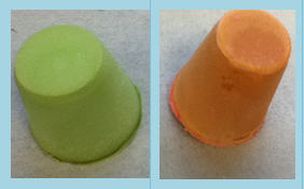
Make soap to understand saponification
Take a closer look at an everyday item: soap! Use oils and other ingredients to make your own soap, learning about esters and saponification. Tinker with the formula to find one that fits a particular set of parameters.
Learn more: Saponification
Uncover the secrets of evaporation
Explore the factors that affect evaporation, then come up with ways to slow them down or speed them up for a simple science fair project.
Learn more: Evaporation
More Chemistry Experiment Science Fair Ideas
These questions and prompts can spark ideas for unique chemistry experiments:
- Compare the properties of sugar and artificial sweeteners.
- Explore the impact of temperature, concentration, and seeding on crystal growth.
- Test various antacids on the market to find the most effective product.
- What is the optimum temperature for yeast production when baking bread from scratch?
- Compare the vitamin C content of various fruits and vegetables.
- How does temperature affect enzyme-catalyzed reactions?
- Investigate the effects of pH on an acid-base chemical reaction.
- Devise a new natural way to test pH levels (such as cabbage leaves).
- What’s the best way to slow down metal oxidation (the form of rust)?
- How do changes in ingredients and method affect the results of a baking recipe?
Like these chemistry experiments? Don’t miss STEM Activities for Kids of All Ages and Interests .
Plus, get all the latest teaching news and ideas when you sign up for our free newsletters.

You Might Also Like

80 Best High School Science Experiments and Projects for Every Subject
Fire up the Bunsen burners! Continue Reading
Copyright © 2024. All rights reserved. 5335 Gate Parkway, Jacksonville, FL 32256

10 Awesome Chemistry Experiments for High School Students
The subject of chemistry is one subject that sends shivers down the spines of students, and sometimes even parents(maybe when they remember their own high school days). Yet chemistry is everywhere, right from the food we eat to the pharmaceuticals we use and the cosmetics we are so fond of.
Therefore, performing certain fun-filled experiments with our high schoolers is a sure-shot way to get the fear of chemistry out of their minds. Where fear stops, curiosity is aroused. Hence, let the learning begin.
Fun-filled chemistry experiments for high school students
1. mystical cloud.
To create the mystical cloud, perform the following steps:
- In an opaque bottle, mix 30% hydrogen peroxide.
- Lower a tea bag containing potassium iodide into the bottle.
- The exothermic reaction between the hydrogen peroxide and potassium iodide will rapidly release oxygen gas, forming a large, mystical-looking cloud in the bottle.
Explanation:
This experiment demonstrates the chemical reaction that produces the cloud, as well as the concept of gas formation. The opaque bottle creates a dramatic visual effect, making the cloud appear “mystical.”
This mystical cloud experiment is sure to catch the eye, as well as the young minds of our high schoolers and get them started on the chemistry journey!
2. Dancing spaghetti experiment
Here is how to do the dancing spaghetti chemistry experiment:
- Pour 1 cup of water into a tall clear glass and add 2 teaspoons of baking soda. Stir until the baking soda is fully dissolved.
- Break uncooked spaghetti noodles into 1-inch pieces and place about 6 pieces into the glass. The spaghetti will sink to the bottom.
- Add 5 teaspoons of vinegar to the glass. Observe as the spaghetti pieces start to rise up and “dance” around due to the chemical reaction between the baking soda and vinegar producing carbon dioxide gas bubbles.
- As the spaghetti dance slows down, add a bit more vinegar to keep the reaction going and the spaghetti dancing.
The spaghetti dances because the carbon dioxide bubbles attach to the rough surface of the noodles, decreasing their density so they float up. When the bubbles pop at the surface, the spaghetti sinks again until more bubbles form. This demonstrates the principles of buoyancy and chemical reactions.
This dancing spaghetti experiment will help the student understand the magic of chemistry in lifting the spirits of scientific inquiry.
3. Bouncy balls to explore polymer properties
Steps to make the bouncy balls:
- Mix 3 level spoonfuls of Elmer’s glue (which contains the polymer polyvinyl acetate), with 5 mL of water and 1 level spoonful of borax powder(which forms cross-links between the polymer chains). Allow to interact for 10-15 seconds before stirring.
- Once the mixture becomes difficult to stir, remove it from the container and knead it with your hands. The ball will start to be sticky and messy but will solidify as you knead it.
- Record observations about the ball’s appearance, stretchiness, and bounciness.
- Try varying the amounts of glue, water, and borax, or adding cornstarch to see how it affects the final bouncy ball properties.
This experiment allows students to explore how changing the polymer composition and cross-linking affects the physical properties of the resulting material. It’s a great hands-on way to learn about the versatile nature of polymers.
The bouncy balls are an exciting and fun-filled experiment to understand everyday applications of chemistry.
4. Colourful flames experiment
Here are some ways to create colorful flames by adding different chemicals :
- Sprinkle salts like sodium chloride (table salt), copper(II) chloride, strontium chloride, or barium nitrate into an alcohol flame to produce yellow, green, red, or blue colors. The heat excites the atoms in the salts, causing them to emit characteristic colored light as the electrons return to their ground state.
- Soak wood chips or sawdust in solutions of metal salts like copper sulfate (blue-green), strontium chloride (red), lithium chloride (pink), or boric acid (green). Allow to dry, then toss the treated chips onto a campfire to produce colored flames.
- Embed metal salts into paraffin wax to make “colored fire wax cakes”. Melt wax in a double boiler, mix in the desired salts, pour into cupcake liners, and let harden. Toss the wax cakes onto a fire for long-lasting colored flames.
Explanation :
The colors produced depend on the specific metal ions present. Sodium gives yellow, copper gives blue-green, strontium gives red, and barium gives green flames. The colors are produced because the metal ions in the salts emit light at specific wavelengths when heated in the flame. This is the same principle used to create colored fireworks
Creating colorful flames by adding different chemicals to a flame is a beautiful rainbow experiment to spark an igniting and everlasting flame of interest for chemistry.
5. Extracting anthocyanin pigment from red cabbage to create a natural pH indicator
To extract anthocyanin pigment from red cabbage and create a natural pH indicator, follow these steps:
- Chop red cabbage leaves into fine pieces to allow the water to extract the anthocyanins.
- Add the chopped cabbage to a pot and cover with distilled water. Bring the mixture to a boil, then simmer for 25 minutes, stirring occasionally
- Filter the solution through a coffee filter or strainer to remove the cabbage pieces, leaving just the anthocyanin-infused water
- (Optional) Boil off 20-50% of the solution to concentrate the anthocyanins for more vibrant colors.5
- Use the anthocyanin solution to test the pH of various household substances:
- Acids like lemon juice, vinegar, and grapefruit juice will turn the solution red.
- Neutral substances like water will keep the solution blue or purple
- Bases like baking soda and ammonia will turn the solution green or yellow.
The anthocyanin pigments change color due to a chemical reaction that occurs at different pH levels. This natural pH indicator provides a fun way to explore acids, bases, and neutrals.
This red cabbage experiment thus is an exciting experiment to familiarise the students with the entire spectrum of pH with its acids, bases, and neutrals!
6. Elephant toothpaste experiment
The key steps to form the elephant toothpaste foam are:
- Mix 1/2 cup of 3% hydrogen peroxide with a squirt of dish soap in a plastic bottle.
- Add a few drops of food coloring if desired.
- In a separate cup, mix 1 tablespoon of yeast with 3 tablespoons of warm water. Stir for 30 seconds.
- Quickly pour the yeast mixture into the bottle and watch the foamy reaction erupt.
The reaction occurs because the catalyst (yeast or potassium iodide) speeds up the decomposition of the hydrogen peroxide into water and oxygen gas. The dish soap traps the oxygen bubbles, creating a dramatic foaming effect. The reaction continues as long as there is hydrogen peroxide and a catalyst remaining.
Thus, this exothermic reaction creates the elephant toothpaste, as well as exponentially engages the curiosity of the students performing the experiment.
7. Chromatography with coffee filters
Chromatography with coffee filters is a simple science experiment that demonstrates the separation of colors in ink or dye. To do this experiment:
- Draw a circle with a washable marker on a coffee filter, leaving the center blank. Fold the filter into a triangle.
- Suspend the folded filter in a cup of water, making sure only the tip touches the water. The water will travel up the filter, separating the colors in the marker.
- After 15-30 minutes, the colors will separate and become visible on the filter. Common results show blue, green, and red/pink colors emerging from the original black marker.
This experiment works because of capillary action and chromatography – the water carries the water-soluble dye molecules at different rates through the filter material. However, it is important to remember that Permanent markers do not work as well since their dyes are not water-soluble.
The separation of colors provides a spectacular result that will surely capture the imagination of young minds!
8. Lava lamp experiment
Steps to create the spectacular lava lamp:
- Fill a clear plastic bottle about 1/4 full with water. Pour vegetable oil into the bottle until it is almost full, then wait a couple of minutes for the oil and water to separate.
- Add a few drops of food coloring, which will sink through the oil, and mix with the water
- Break an Alka-Seltzer tablet into pieces and drop them into the bottle. The tablet will sink to the bottom, start dissolving, and release carbon dioxide gas bubbles.
- The bubbles will attach to the colored water blobs, making them float to the top. When the bubbles pop, the colored water will sink back down.
The lava lamp works because oil is less dense than water, so it floats on top. The food coloring has the same density as water, so it sinks through the oil. The gas bubbles from the Alka-Seltzer are lighter than water, so they float up, bringing the colored water with them
Fun tip: To keep the lava lamp going, just drop in another piece of Alka-Seltzer tablet when the bubbling slows down. Your evergreen lava lamp may just spark a permanent love for all chemicals and chemistry!
9. Magic milk experiment
The magic milk experiment demonstrates how soap interacts with the fats and proteins in milk:
- The magic milk experiment involves pouring milk into a shallow dish and then adding food coloring.
- It is followed by touching a cotton swab dipped in dish soap to the surface of the milk. This causes the food coloring to swirl and dance around, creating a colorful “fireworks” effect.
The reason this happens is that the soap molecules have a hydrophilic (water-loving) end and a hydrophobic (water-fearing) end. When the soap touches the milk, the hydrophobic ends attach to the fat molecules, causing them to move around rapidly. The food coloring gets swept up in this motion, resulting in a colorful display.
Another way to get even more creative with the experiment is to try it with different types of milk to see how the fat content affects the results. The more fat in the milk, the more dramatic the color display will be, and faster your student will be fascinated with chemistry!
10. Ammonia fountain experiment
The ammonia fountain experiment demonstrates the high solubility of ammonia gas in water due to hydrogen bonding. Here’s how it works:
- A flask is filled with dry ammonia gas by heating a mixture of calcium hydroxide and ammonium chloride.
- Water is injected into the flask through a syringe, causing the ammonia gas to rapidly dissolve. This creates a partial vacuum inside the flask.
- The external atmospheric pressure forces water up a tube and out through a jet, creating a fountain effect. The ammonia solution is alkaline, so adding a pH indicator like phenolphthalein turns it pink.
- As more ammonia dissolves, the pressure inside the flask drops further, causing the fountain to continue for several minutes.
This experiment illustrates the concepts of solubility, gas laws, and acid-base chemistry at an introductory level. It can also be done with other highly soluble gases like hydrogen chloride.
The ammonia fountain experiment will surely skyrocket your high schooler’s interest in chemistry experiments and the various explanations of the world it opens to them.
Chemistry is often referred to as the “central science” because it connects various fields, including physics, biology, and environmental sciences. Thus, it is absolutely imperative that students not view it as a textbook roadblock on the way to graduation. Rather, it should be seen as an exciting hiking trip that will become more adventurous while passing each milestone.
The same holds true for physics. And we can prove to you that physics can be fun too with these physics experiments for high school students!
An Engineer, Maths expert, Online Tutor, and animal rights activist. I have more than 5 years of teaching experience and have worked closely with students with learning disorders. I have worked with special educators, counselors, and experts in dealing with common issues that students face during their academic journey.
Leave a Comment Cancel reply
Save my name, email, and website in this browser for the next time I comment.

IMAGES
COMMENTS
Whether you’re a student eager to explore the wonders of chemical reactions or a teacher seeking to inspire and engage your students, we’ve compiled a curated list of the top 68 chemistry experiments so you can learn about chemical reactions.
There are many interesting and fun projects to try, but these 10 chemistry experiments might be the coolest. Whether you want to witness color transformations with copper and nitric acid or create a foam spectacle with hydrogen peroxide and potassium iodide, there's something here to spark curiosity in everyone.
Everybody loves chemistry experiments! We’ve rounded up the best activities, demos, and chemistry science fair projects for kids and teens. Try them in the classroom or at home. Jump to: These chemistry experiments and activities are all easy to do using simple supplies you probably already have.
Fun-filled chemistry experiments for high school students 1. Mystical Cloud. To create the mystical cloud, perform the following steps: In an opaque bottle, mix 30% hydrogen peroxide. Lower a tea bag containing potassium iodide into the bottle.
It is thrilling to see it lift off and escape Earth's gravity. Did you know that it takes a chemical reaction to get a spacecraft into space? Every time you see a one blast off, you are watching chemistry at work. In this chemistry science fair project, you will also get to blast an object into the air.
Check out this large list of chemistry experiments for kids of all ages. We have them arranged in grade order. Easily find an engaging chemistry experiment to add to your homeschool or classroom this week.